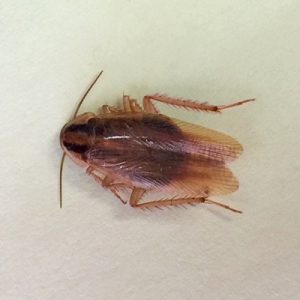Scientific Name: Blattella germanica
Common Names: German cockroach
Color: Varies from light brown to tan
Size: 13 to 16 mm long
FACT: German cockroaches have wings but do not use them to fly!
HABITS
German cockroaches are becoming the most common household insect within the United States and Canada. This pest typically infests kitchens and bathrooms but will live anywhere inside heated structures for food, water and harbourage. German cockroaches can gain entry into structures in bags, cardboard boxes, drink cartons, infested equipment such as used refrigerators, toasters, microwaves, etc.
- Feeding: German cockroaches are omnivorous scavengers, feeding on all types of human food as well as on pet food, toothpaste, soap, glue, etc.
- Hibernation: German cockroaches will live inside of buildings where the temperature is warmer; they will easily live through the entire winter and continue to multiply provided they have water and a food supply.
- Nesting: German cockroaches are active at night, leaving their harbourage to find food and water. They remain hidden in their dark, secluded harbourage areas (under cupboards, behind cabinets, in wall voids, and around motor housings in appliances) where they spend 75% of their time.
- Reproduction: German cockroaches grow from egg to reproductive adult in about 50 – 60 days. Their entire lifespan is approximately 200 days. Once fertilized, the purse shaped egg capsule of the German cockroach is light brown in color, 6.4 to 9.3 mm long and typically has 15 to 20 eggs per side for approximately 30-40 total young. The young emerge roughly 24 hours after the egg capsule has been released from the female’s body after 30-35 days. About half of all nymphs die before reaching adulthood; the molted skin and dead are eaten by other cockroaches when they emerge if there are not other food sources.
CONTROL
Because German cockroaches are typically brought into structures, potentially infested products should be closely inspected. Many types of cardboard and plastic traps are available to help pinpoint sources of cockroach infestation and to monitor areas which occupants have complained but infestations cannot be visually detected. Sticky traps are not intended for control but, rather, help identify harbourage areas and to guide and evaluate control efforts as part of the inspection process.
An effective cockroach management program depends on good sanitation to eliminate food, water and harbourage sites they need for survival. Clean-up to reduce cockroaches in the home and office environment must focus mainly on the food residue in and around coffee machines, microwave ovens, stoves, refrigerators, trash cans, furniture and areas where exposed food is stored. It is critical to reduce clutter, as cockroaches like to hide in stacked boxes and locations near food and water. Vacuum cleaning can be used to physically remove exposed cockroaches. Permanent reduction of cockroach populations can be achieved by caulking to eliminate harbourage areas. The most important piece is too eliminate cracks to reduce hiding sites. These include those in which sinks and fixtures are mounted to the wall and/or floor, around all types of plumbing, baseboard moulding and corner guards where shelves and cabinets meet walls and door frames as well as cracks on or near food preparation surfaces.
Cockroach access routes between apartments and from wall voids and around plumbing and electrical fixtures should be sealed with caulk or grout. Basement floor drains should be protected with screens or basket inserts which should be cleaned regularly.
Residual sprays should be applied to ALL cracks, crevices and around baseboards. Read and follow the label instructions before using ANY product. Even if activity has not been detected within a room, precautions should be taken with a thorough spray treatment of the entire home or business. Also, you should apply insect dust to various cracks and crevices throughout the building. Harbourage areas (under fridge and stove, cracks, crevices, pipe chases, around the toilets and under the kitchen bathroom sinks) should be treated. Once the treatment is done, you must vacate the home for at least 4-6 hours. Infants, seniors, pregnant and people with asthma or health issues should stay away for longer periods of time.
Gel baits may also be used to control cockroaches; however sanitation plays an important factor to ensure the cockroaches consume the bait and not other food stuffs.
If you are at all concerned about the state of your home, call Poulin’s. With locations in British Columbia, Alberta, Saskatchewan, and Manitoba, we can setup a monitoring program and if you have cockroaches a treatment program to rid your home of these roaches.

